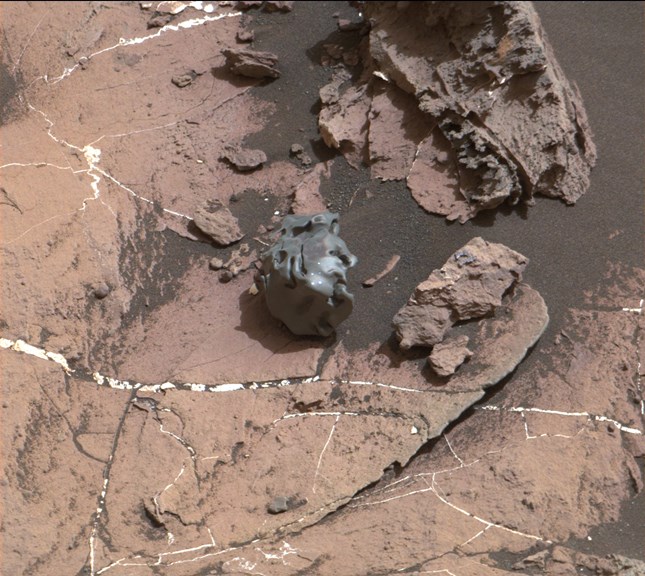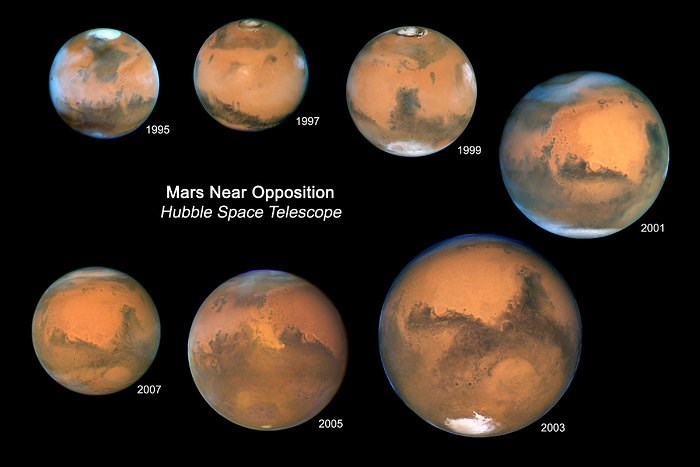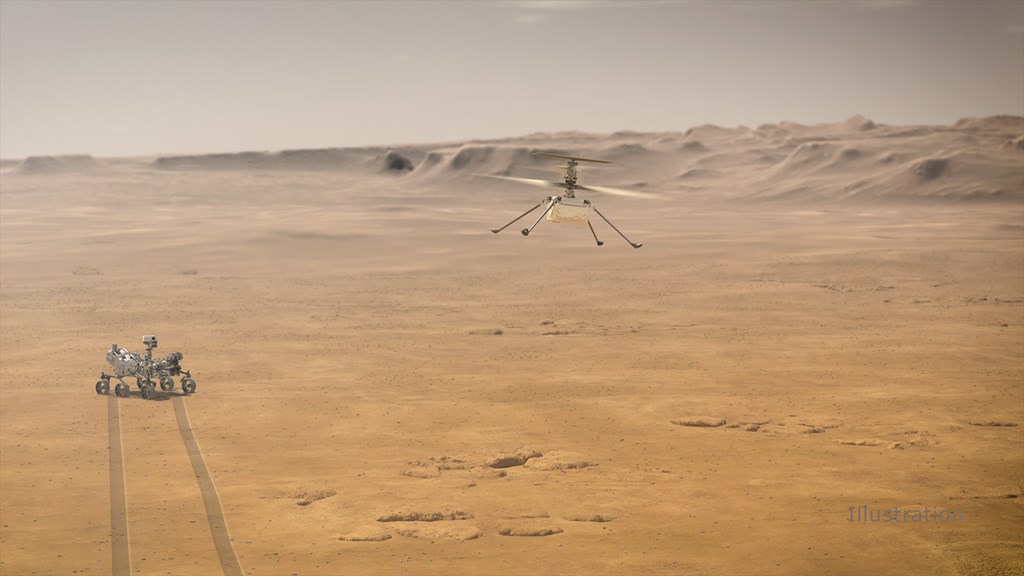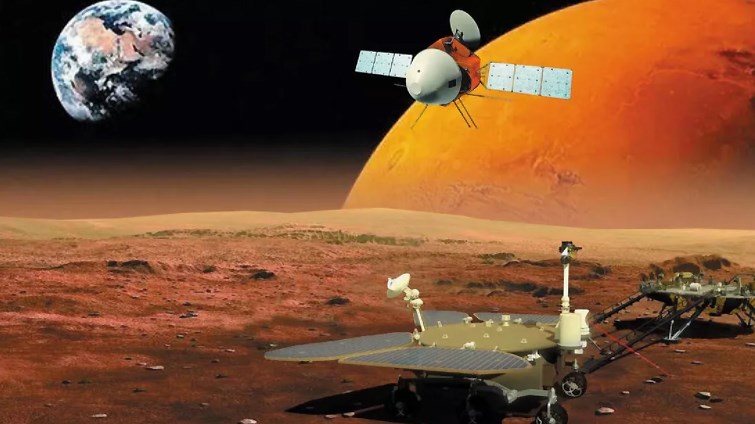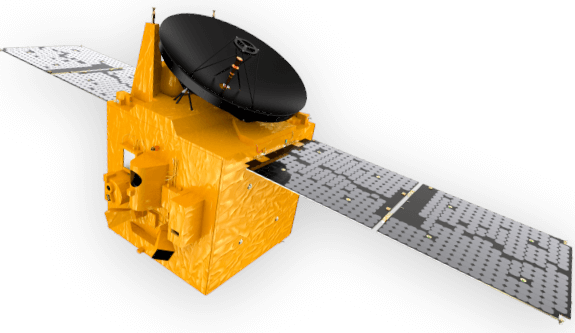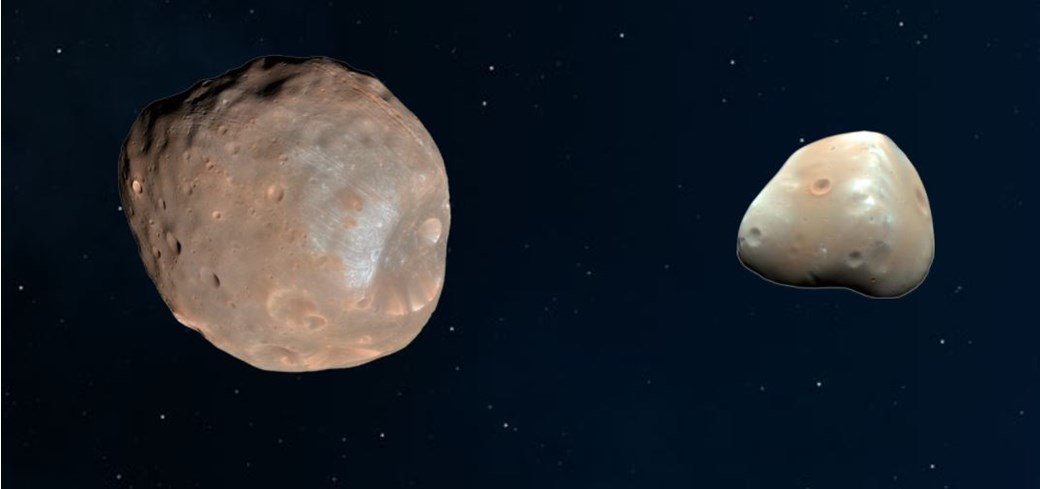Mars Ahoy!
The Red Planet moves into opposition this month. It will line up so that we will have the Sun on one side of us and Mars on the other, in opposition as astronomers say – an ideal planetary alignment and perfect for viewing that fascinating terrestrial world.
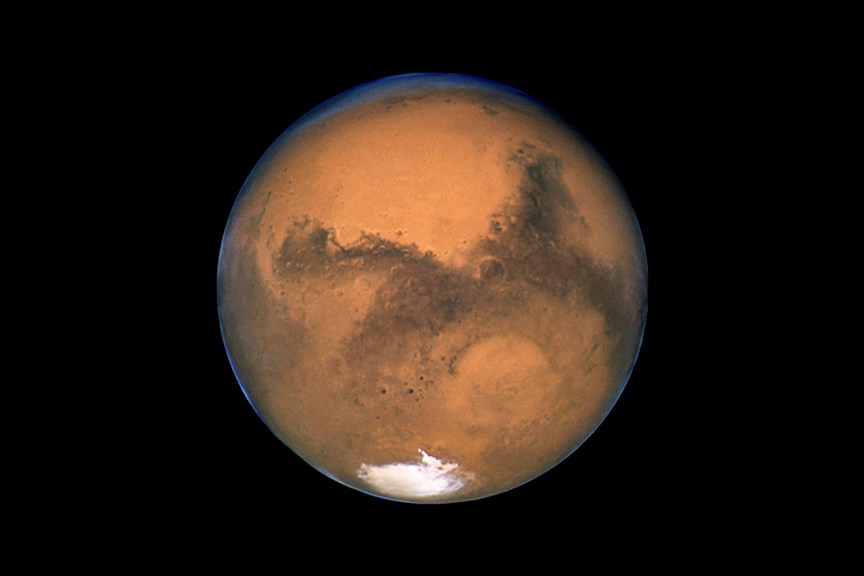
Mars is also in the news for other exciting reasons. Three more missions are heading there from China, UAE and USA. We’ll delve into each a little.
And to end our Mars special we’ll have a light-hearted look at the moons of Mars that are so different to our lunar neighbour.
Magnificent Mars
The planets orbit the sun in a roughly flat plain, and as Johannes Kepler established in 1604, they travel in paths that are elliptical (very nearly circular but not quite) and have different orbital speeds according to how far they are from the sun. Close in planets orbit faster compared to those further out. Being further out than us, Mars travels slower but every 790 Earth days our planet gradually passes Mars on the inside lane in the solar system racetrack.
For a short few weeks Sun, Earth and Mars line up and we get to see Mars close, big and bright before we draw away in our faster track. Such an opposition begins this month and will last into November, but adding value to this particular event will be its proximity, a very favourable 62.7 million km. Not the closest Mars ever gets, but very good nonetheless. In fact, it won’t get this close again for another 15 years.
Quick Mars facts
- Mars varies from 200 to 250 million km from the sun, compared to Earth’s 150 million km.
- It’s one of the four inner terrestrial (rocky) planets.
- It takes 687 days (1.9 Earth years) to orbit the sun.
- Mars is 15% the size and 11% the mass of Earth.
- Gravity is 37% of Earth’s.
- Almost a sphere with an equatorial diameter only 50 km more than its polar diameter.
- Air pressure is extremely low, 1% of Earth’s at sea level.
- Atmosphere is 98% carbon dioxide, 2% argon, 2% nitrogen, with trace amounts of water vapour, carbon monoxide and oxygen.
- Winds are slow under 30 km/h, but during dust storms can reach 100 km/h.
- It has no inner dynamo to create a strong global magnetic field.
- It has a weak patchy magnetosphere due to interaction of thin atmosphere and solar wind.
- Surface temperatures range from -143 C to +35 C with an overall mean of -63 C.
- Its axis is titled by 25 degrees (Earth’s is 23.5 degrees).
- A Martian day is 24.5 hours long.
- Largest volcano in the solar system, Olympus Mons, a dormant shield volcano 26 km high.
- Largest canyon complex in the solar system, Valles Marineris, 3000km long, 8 km deep and up to 600km wide.
- Its bright polar caps are solid carbon dioxide (dry ice) on a bed of frozen water.
- It has two small moons, Phobos and Deimos.
- Mars shows evidence of liquid surface water in the past, and subsurface liquid water today.
- Earth receives meteorites (some from Mars!) and Mars gets them too.
Mars is an obvious orange-red object in the night sky and it’s easy to see it change position over only a few nights. Each time you observe it will have moved a little against the background of distant stars. The origin of ‘planet’ is from the Greek planetos, meaning wanderer. All the planets do this as seen from Earth.
With a modest telescope you can see the disc of Mars and dark and light markings indicating surface features. The white polar caps can be seen, however due to its titled axis, its north polar cap will this time be turned away from view. But equally that makes the south pole cap more visible as it will be turned towards us. The southern cap is made of frozen carbon dioxide (dry ice) some three kilometres thick over a bed of frozen water, while the north cap is a dusting of carbon dioxide ice that fluctuates seasonally.
Missions to Mars
After 60 years of missions involving fly bys, orbiters, landers and rovers, over half of which have failed, the probes currently orbiting Mars and those on the surface are to get more company as three new missions to the Red Planet are underway.
Perseverance - NASA’s Fifth Martian Rover
Following on from Sojourner (1997), Sprit and Opportunity (2003), and Curiosity (2012), a new rover is heading to Mars and is due to land on February 18 next year in Jezero Crater in the northern hemisphere. Like Gale Crater for Curiosity, the region was once an ancient lake fed by rivers which has implications for past climate and the possibility of life. The landing will be by Sky Crane which was a great success for the Curiosity rover in 2012. Aerobraking and parachutes are used at first but thrusters are used in the final minutes. However, in the last few moments the rover is released to hang suspended by cables. When the rover’s wheels gently touch the surface, the cables are quickly severed and the upper stage blasts away to crash safely elsewhere leaving the rover sitting on the surface.
NASA’s Perseverance rover will have on board a passenger, Ingenuity, a small lightweight short-range helicopter (maybe marscopter?). It will be an experiment with flying in the thin Martian atmosphere. It will attempt to remain in wireless contact with Perseverance for up to 1km as it attempts brief flights, landing and recharging each time, during its anticipated short life.
Although based on Curiosity and looking similar, Perseverance is a much more advanced car-sized rover with spectrometers, cameras, ground penetrating radar, an experimental terrain hazard avoidance system, an oxygen generation experiment, and a sophisticated environment and weather station. A major goal is to take rock and soil samples and seal them for possible future Earth return. While the helicopter life will be short, Perseverance itself is planned to last a full Martian year (1.9 Earth year), however, if other NASA rovers are any indication it could function for much longer.
Tianwen 1 – China’s three-in-one
After the Chinese National Space Administration’s highly successful lunar mission in 2018 that delivered lander Chang’e 4 and little rover Yutu 2 (Jade Rabbit) to the farside of the moon, another mission is underway. China launched on 23 July its Tianwen 1 (“quest for heavenly truth”) - an ambitious three-in-one mission to Mars involving orbiter, lander and rover.
Due to arrive in February next year the orbiter will study the planet for a couple of months before releasing the lander and rover to descend to the surface in April or May. The landing site is likely to be the Utopia Planitia region in the northern plains of Mars. Goals include geological mapping, soil analysis, atmospheric conditions, and gravitational studies. Both orbiter and rover have, among other instruments, cameras, ground penetrating radar, and spectrometers.
Hope – United Arab Emirates Mars Mission
The UAE Space Agency was established in 2014 and has a program aligned with the goals of the international Mars Exploration Program Advisory Group (MEPAG) which fosters investigations of Mars in four main areas; past or present life, climate, geological systems, and preparing for human exploration.
Hope (Al-Amal in Arabic) is an orbiter and Emirates first space mission. Launched from Japan’s Tanegashima Space Centre on June 20 it is expected to go into Martian orbit in February next year and operate for at least one Martian year (1.9 Earth years).
The craft will enter a highly inclined elliptical orbit of 55 hours ranging from 20,000 km to 43,000 km. This will allow a broad all-seasons planetary-wide study of the planet. It will examine climate and weather, with special focus on the differences between lower and upper atmospheric layers and the loss of hydrogen and oxygen to space. The orbiter will use ultraviolet and infrared spectrometers and a high-resolution imager.
Moons of Mars
Fancy a trip to Mars? It has some weird moons. If you ever get there be sure to step outside and stand for a while on its dusty sub-zero surface (safe in your protection suit with oxygen pack). Now, look up and gaze in wonder as two amazing potato moons go zipping by.
You’d see Phobos and smaller Deimos hurtle by much faster than Earth’s slow moon. From your space training you’d remember the Moon is 3,500 km in diameter and orbits Earth at 380,000 km on average. It does that in about 28 days. But after your Mars New Arrivals Orientation you’d know Phobos is 22 km in diameter and orbits very close three times a day at 6,000 km. Being small and close it would look about a third the size of the Moon as seen from Earth.
Deimos is much further out at 23,000 km and takes 30 hours to orbit. Unlike the ponderous big old Earth moon, from the Red Planet you’d easily see those two moons move across the Martian sky as you watched. In fact, NASA’s Curiosity Rover on Mars did just that. In 2013 it looked up and took a stunning video of one crossing in front of the other!
But why “potato”? From the picture and the video you can guess. They look like spuds drawn in from some other part of the solar system. They seem to be like lumpy asteroids with craters and could possibly be no more than loose piles of rubble that were caught in Mars’ gravity and ended up with only one side facing the Red Planet.
For explorers and settlers, these two moons could be a convenient staging post to the Martian surface. They might provide an observation or communications platform.
And their names? Well, the ancient Roman god of war was Mars, but his Greek counterpart Aries had two horses, Phobos and Deimos, pulling his battle chariot. When the two little moons were discovered in 1877 what better names than Phobos who evoked panic and Demos inspired terror and dread. No wonder humans are fixated on the fourth planet with stories and movies of fearful invaders from Mars.
Strange too is the fate of Phobos. It’s moving in an ever-tightening orbit getting closer to Mars by a couple of metres every century. In the future, some 50 million years from now, it will get too close, cross a dynamic threshold known as the Roche Limit and break up.
Imagine that! Chunks of the moon raining down blasting out new craters on the surface. Or maybe its fragments might instead form a small dusty ring for future eyes to behold. Not bright like Saturn’s glorious ice rings - more like the dark ones around Neptune or Uranus. A ghostly relic leaving only little Deimos in high orbit as the last of Mars’ weird potato moons.
Related links
